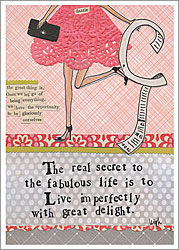
Last Saturday I was in Gypsy Moon with a very good friend. Gypsy Moon is a quirky little shop with unusual things located on Randolph Avenue in St. Paul. You’ll find it across the street from the University of St. Catherine, in the neighborhood where I grew up.
If, when you are there, you go all the way to the back of the shop, past the rusting metal planters, beyond the antique armoire and the display of artisan jewelry, you will find an additional small room. There on the table I saw it. It was printed on a Curly Girl greeting card – what I learned from another very good friend – so I purchased it and sent it to her.
“What was it?” you might ask. It was the secret to a fabulous life. But it was short and sweet and summed up in very few words.
On the card was written this:
The real secret to the fabulous life
is to live imperfectly with great delight.
It is so very true! In the end, this is all we can do. Nothing is ever perfect and it is best when it is imperfect. It was all created this way, but not by us. We should accept the gift and delight in it. Give up our ideas of how we think our lives should be or should have been. Instead, embrace the life we have been given. Compassionate and forgiving theology – a gift, as modeled by a very god friend and now it seems, on a greeting card.
You may also like Authentic Living – Life Editing and Market Flowers – Fabulous.



